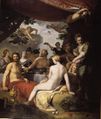ابراهام بلومرت
| ابراهام بلومرت Abraham Bloemaert | |
|---|---|
 ابراهام بلومرت في Het Gulden Cabinet، 45 | |
| اسم الميلاد | ابراهام بلومرت |
| وُلِد | 1564-12-25 جورينشيم |
| توفي | 1651-01-27 اوتريخت |
| الجنسية | هولندي |
| المجال | رسام |
| التدريب | Hieronymus Francken among others |
| الحركة | Northern Mannerism and Dutch Baroque painting |
ابراهام بلومرت Abraham Bloemaert (عاش 1566 - 27 يناير 1651) كان رساماً هولندياً، وهو واحد من أشهر رسامو العصر الذهبي الهولندي.
. . . . . . . . . . . . . . . . . . . . . . . . . . . . . . . . . . . . . . . . . . . . . . . . . . . . . . . . . . . . . . . . . . . . . . . . . . . . . . . . . . . . . . . . . . . . . . . . . . . . . . . . . . . . . . . . . . . . . . . . . . . . . . . . . . . . . . . . . . . . . . . . . . . . . . . . . . . . . . . . . . . . . . . .
حياته
Bloemaert was born in Gorinchem, the son of the architect Cornelis Bloemaert I, who moved his family to Utrecht in 1575, where Abraham was first a pupil of Gerrit Splinter (pupil of Frans Floris) and of Joos de Beer.[1] From the age of 15 or 16, he then spent three years in باريس from 1581–1583, studying six weeks under a Jehan Bassot (possibly Jean Cousin the Younger) and then under a Maistre Herry.[1] While in the School of Fontainebleau he received further training from his fellow countryman Hieronymus Francken.[1] He returned to Utrecht in 1583, just before the French Wars of Religion began, which destroyed much of the work at the Chateau of Fontainebleau. When his father was appointed city architect (Stads-bouwmeester) in Amsterdam 1591 he accompanied him there, and on his father's death in 1593 returned finally to Utrecht, where he set up a workshop and became dean ("deken") of the "zadelaarsgilde" (traditional name of the Utrecht Guild of St. Luke from 1367 onwards) in 1594.[2] In 1611, along with Paulus Moreelse, he was one of the founders of a new Utrecht painters' guild, called "St. Lucas-gilde", and became its deken in 1618.[2] Many of Bloemaert paintings were commissioned by Utrecht's clandestine Catholic churches.[3] He died in Utrecht.
He excelled more as a colourist than as a draughtsman, was extremely productive, and painted and etched historical and allegorical pictures, landscapes, still-life, animal pictures and flower pieces. In the first decade of the seventeenth-century, Bloemaert began formulating his landscape paintings to include pictoresque ruined cottagges and other pastoral elements. In these works, the religious or mythological figures play a subordinate role. Country life was to remain Bloemaert's favourite subject, which he depicted with increasing naturalism. He drew motifs such as peasant cottages, dovecotes and trees from life and then on his return to the studio, worked them up into complex imaginary scenes.[4]
Among his many pupils are his four sons, Hendrick, Frederick, Cornelis, and Adriaan (all of whom achieved considerable reputation as painters or engravers). The RKD also lists Jan van Bijlert, the two Boths, the two Honthorsts, Leonaert Bramer, Bartholomeus Breenbergh, Hendrick ter Brugghen, Jacob Gerritsz Cuyp, Willem van Drielenburg, Wybrand de Geest, Nicolaus Knüpfer, Cornelis van Poelenburch, Henrik Schook, Matthias Stom, Herman van Swanevelt, Dirck Voorst, and Jan Weenix.[2]
معرض الصور
نيوبه تنتحب على أطفالها، 1591
The Four Evangelists, 1615
يوحنا المعمدان يبشر، ح. 1620
Landscape with Peasants Resting, 1650. Oil on canvas, 91 x 133 cm. (Staatliche Museen, Berlin)
Feast of the Gods at the wedding of Peleus and Thetis, 1638 (Mauritshuis, 17)
منظر طبيعي ورعايا يوحنا المعمدان.
اعادة الاكتشاف
- Lot and his daughters (120 x 220 cm), oil on canvas (rediscovered in 2006 by Prof. Alain Béjard & Dimitri Joannidès, Alicem institute, Luxemburg)
وصلات خارجية
- Paintings by Abraham Bloemaert
- Not two, but three scenes from the Historiae Aethiopicae by Abraham Bloemaert
الهامش
- ^ أ ب ت (هولندية) Abraham Bloemaert in Karel van Mander's Schilderboeck, 1604, courtesy of the Digital library for Dutch literature
- ^ أ ب ت Abraham van Bloemaert in the RKD
- ^ "The Artist's Religion: Paintings Commissioned for Clandestine Catholic Churches in the Northern Netherlands, 1600-1800," Xander van Eck, Simiolus: Netherlands Quarterly for the History of Art, Vol. 27, No. 1/2 (1999), pp. 70-94.
- ^ Bolton, Roy (2009). The Collectors : Old Master Paintings, London, Sphinx Books, pp. 176-179.ISBN : 978-1-907200-03-8.
- تحوي هذه المقالة معلومات مترجمة من الطبعة الحادية عشرة لدائرة المعارف البريطانية لسنة 1911 وهي الآن من ضمن الملكية العامة.
- Infobox person using deprecated parameters
- مقالات مأخوذة من الطبعة الحادية عشرة لدائرة المعارف البريطانية
- Use dmy dates from October 2010
- Persondata templates without short description parameter
- رسامون هولنديون
- طباعو العصر الذهبي الهولندي
- رسامو العصر الذهبي الهولندي
- مواليد 1566
- وفيات 1651
- People from Gorinchem
- أشخاص من اوترخت
- أعضاء نقابة القديس لوقا بأوترخت








